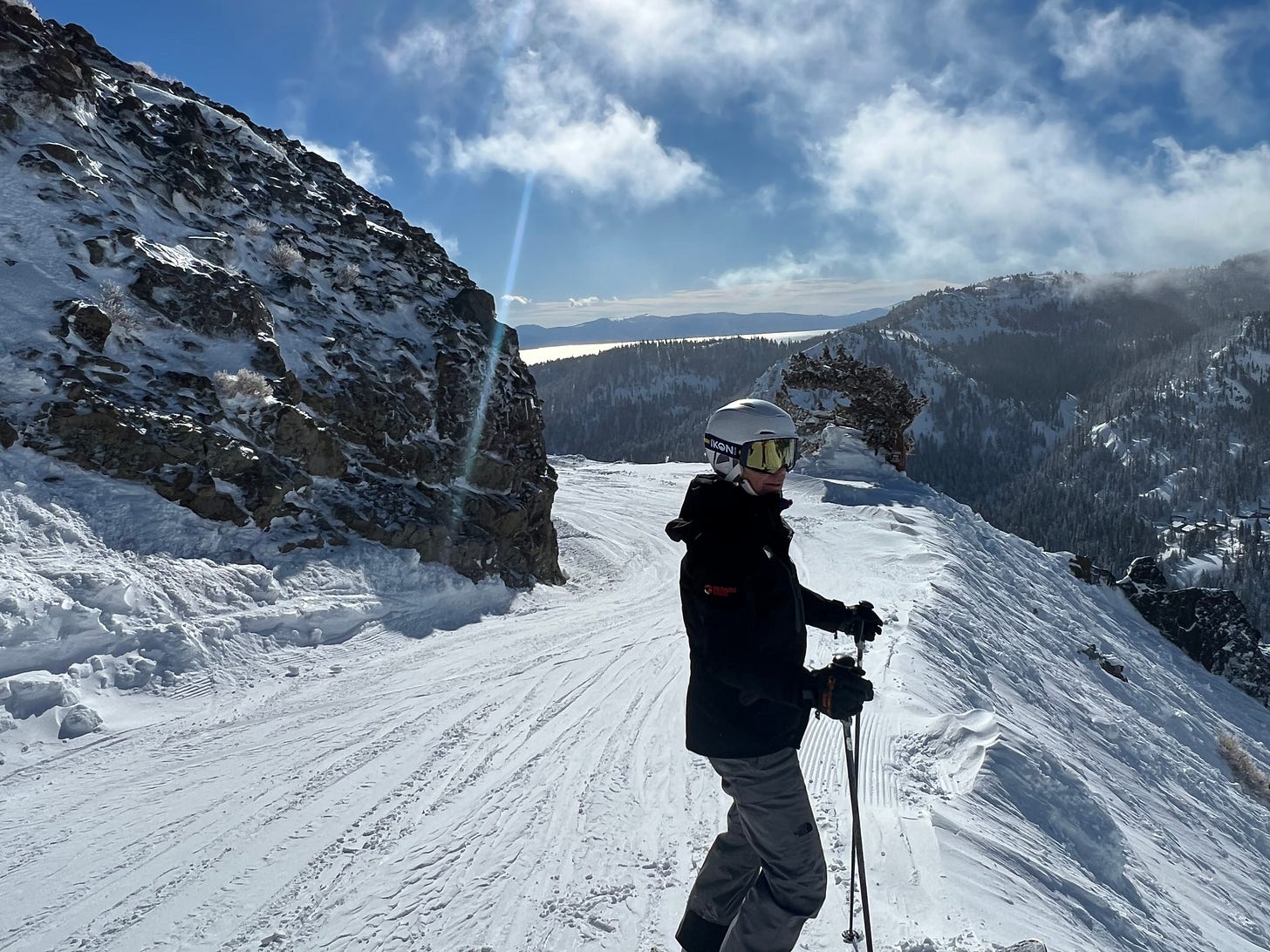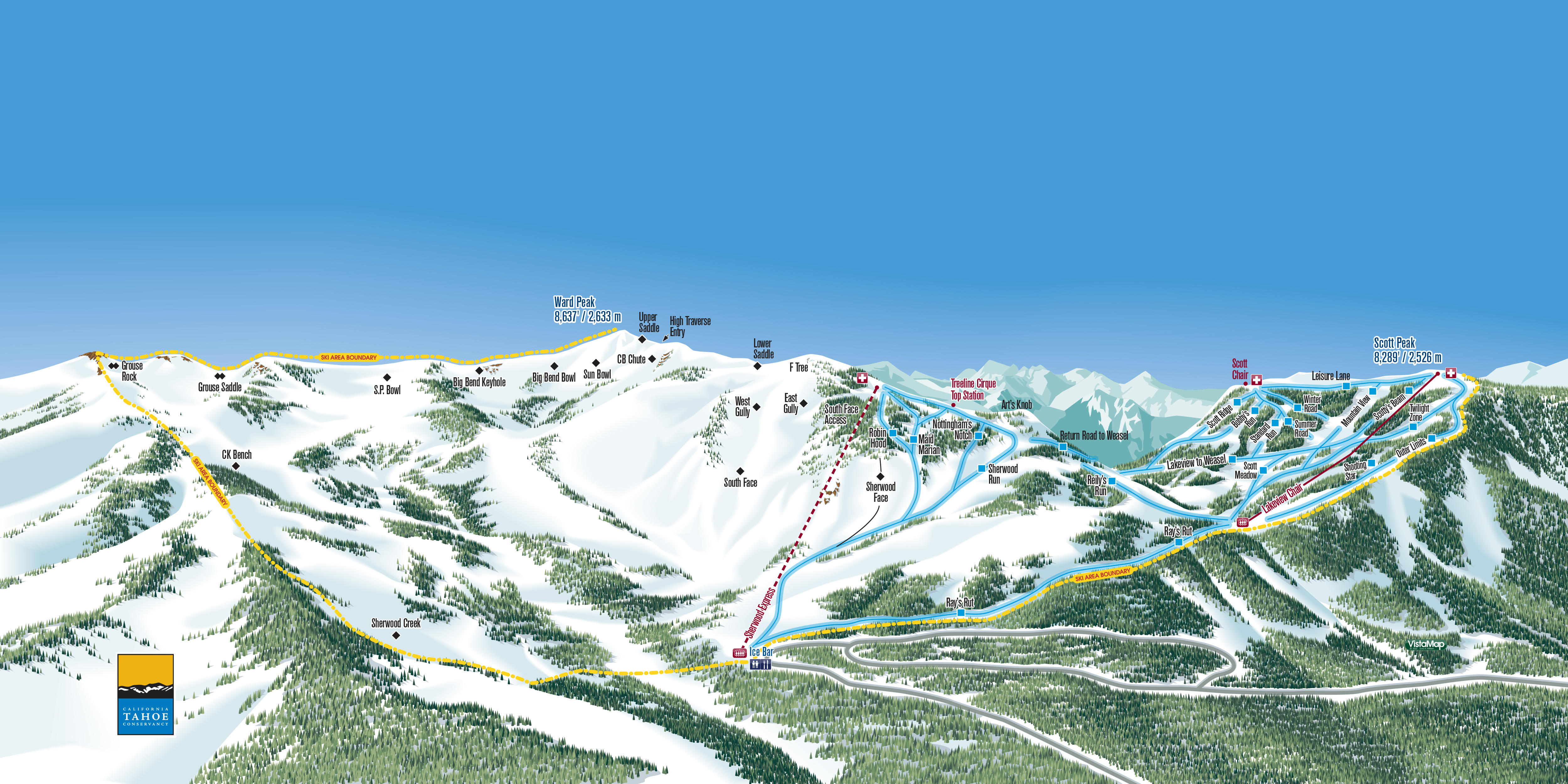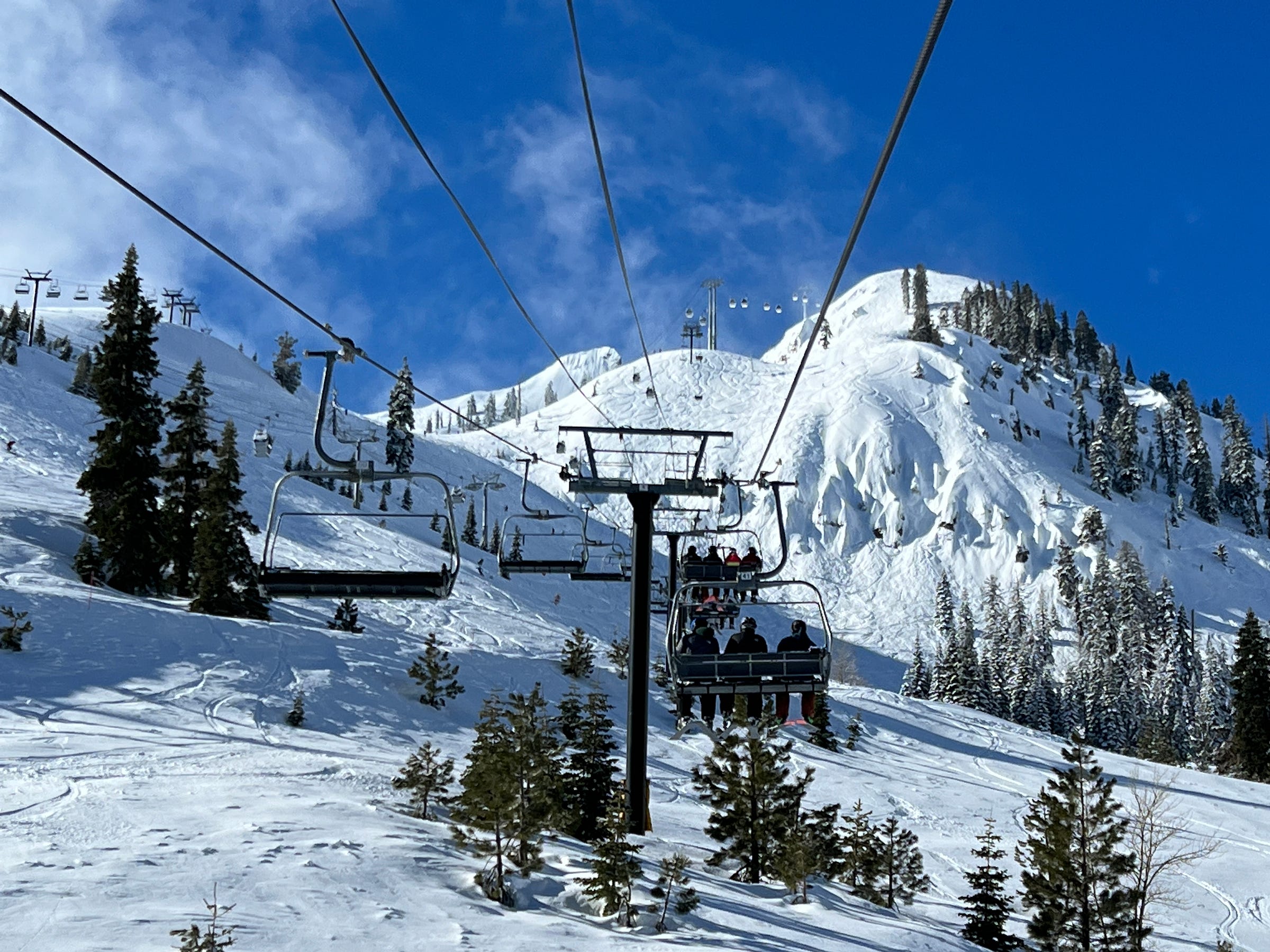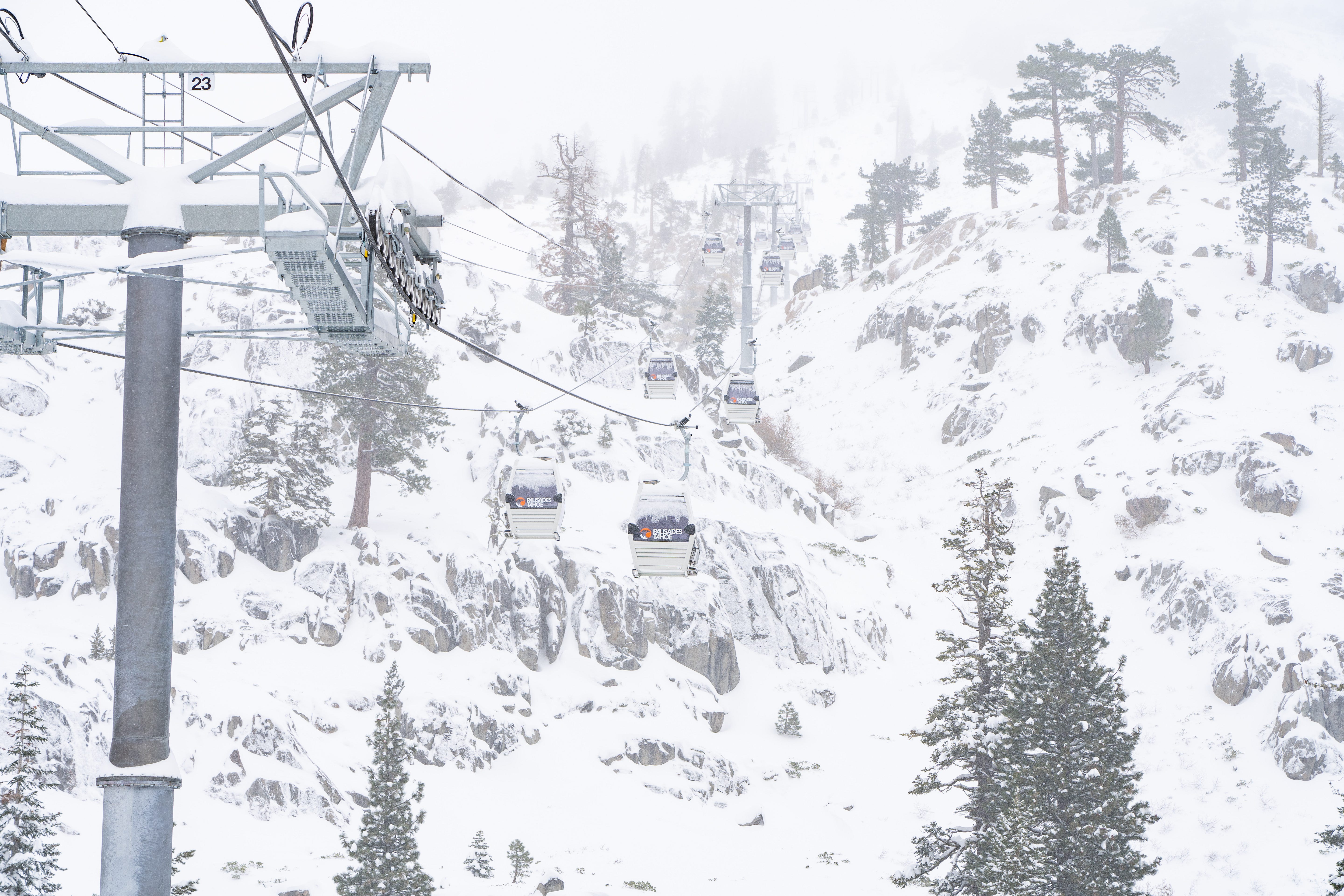Who
Dee Byrne, President and Chief Operating Officer of Palisades Tahoe, California

Recorded on
April 24, 2023
About Palisades Tahoe
Click here for a mountain stats overview
Owned by: Alterra Mountain Company
Pass affiliations: Unlimited access on the Ikon Pass; unlimited access with holiday blackouts on the Ikon Base Pass
Located in: Olympic Valley, California
Year founded:
Palisades/Olympic side (as Squaw Valley): 1949
Alpine Meadows: 1961
Closest neighboring ski areas: Granlibakken (14 minutes from Palisades base), Homewood (18 minutes), Northstar (23 minutes), Tahoe Donner (24 minutes), Boreal (24 minutes), Soda Springs (28 minutes), Donner Ski Ranch (28 minutes), Kingvale (29 minutes), Sugar Bowl (30 minutes), Diamond Peak (39 minutes), Mt. Rose (45 minutes), Sky Tavern (50), Heavenly (1 hour) - travel times vary dramatically given weather conditions and time of day
Base elevation | summit elevation | vertical drop:
Alpine Meadows side: 6,835 feet | 8,637 feet | 1,802 feet
Olympic Valley side: 6,200 feet | 9,050 feet | 2,850 feet
Skiable Acres: 6,000
Alpine Meadows side: 2,400
Olympic Valley side: 3,600
Average annual snowfall: 400 inches (713 inches for the 2023-24 ski season through May 3!)
Trail count: 270-plus
Alpine Meadows side: 100-plus (25% beginner, 40% intermediate, 35% advanced)
Olympic Valley side: 170-plus (25% beginner, 45% intermediate, 30% advanced)
Lift count: 42 (10-passenger tram, 28-passenger funitel, 8-passenger gondola, 8 six-packs, 5 high-speed quads, 1 fixed-grip quad, 10 triples, 8 doubles, 7 carpets - view Lift Blog’s inventory of Palisades Tahoe’s lift fleet)
Alpine Meadows: 13 (1 six-pack, 3 high-speed quads, 2 triples, 5 doubles, 2 carpets)
Palisades/Olympic: 28 (120-passenger tram, 28-passenger funitel, 7 six-packs, 2 high-speed quads, 1 quad, 8 triples, 3 doubles, 5 carpets)
Shared lifts: 1 (8-passenger Base-to-Base Gondola)


Why I interviewed her
Imagine this: I’m a Midwest teenager who has notched exactly three days on skis, on three separate 200-vert bumps. I know vaguely that there is skiing out West, and that it is big. But I’m thinking Colorado, maybe Wyoming. California? California is Beach Boys and palm trees. Surfboards and San Diego. I have no idea that California has mountains, let alone ski resorts. Anticipating the skis, boots, and poles that I’ve requested as the totality of my Christmas list, I pick up the December 1994 issue of Skiing (RIP), and read the following by Kristen Ulmer:
Nothing is random. You live, die, pay taxes, move to Squaw. It’s the place you see in all the ski flicks, with the groovy attitudes, toasty-warm days, wild lines, and that enormous lake. It’s California! Squallywood! It’s the one place where every born-to-ski skier, at some point or other, wants to move to; where people will crawl a thousand miles over broken glass for the chance to ski freezer burn. The one place to make it as a “professional” skier.
My friend Kent Kreitler, a phenomenal skier who doesn’t live anywhere in particular, finally announced, “I think I’m move to Squaw.”
“So Kent,” I said, “let me tell you what the rest of your life will be like.” And I laid it out for him. …
You’re curious to find out if you’re as good a skier as you think. So you find a group of locals and try to keep up. On powder days the excitement builds like a pressure cooker. Move fast, because it only takes an hour for the entire mountain to get tracked up. There’s oodles of cliff jumps and psycho lines. You’d better just do it, because within seconds, 10 other yahoos will have already jumped and tracked out the landing pad.
If you’re a truly amazing skier (anything else inspires only polite smiles and undisguised yawns), then you land clean on jumps and shred through anything with style. If not, the hyperactivity of the place will motivate you to ski the same lines anyway. Either way is fulfilling.
Occasionally a random miracle occurs, and the patrol opens the famed Palisades on Squaw Peak. On those days you don’t bother with a warm-up run – just hike 15 minutes from the top of Siberia Express chair and coolly launch some hospital air off Main Chute.
There are other places to express your extreme nature. When everything else gets tracked, you hike up Granite Peak for its steep chutes. If the snowpack is good, you climb 10 minutes from the top of the KT-22 chair to Eagle’s Nest. And jumping the Fingers off KT-22 seems particularly heroic: Not only do you need speed to clear the sloping rocks, but it’s right (ahem) under the lift.
At the conclusion of that ski season, teenage Stuart Winchester, a novice skier who lived in his parents’ basement, announced, “I think I’m moving to Squaw.”
“No Dumbass,” his mom said, “you’re going to college.”
Which doesn’t mean I ever forgot that high-energy introduction to California extreme. I re-read that article dozens of times (you can read the full bit here). Until my brain had been coded to regard the ski resort now known as Palisades Tahoe (see why?) as one of the spiritual and cultural homelands of U.S. lift-served skiing.

Ulmer’s realm, hyperactive as it was, looks pokey by today’s standards. An accompanying essay in that same issue of Skiing, written by Eric Hanson, describes a very different resort than the one you’ll encounter today:
Locals seem proud that there’s so little development here. The faithful will say it’s because everything that matters is up on the mountain itself: bottomless steeps, vast acreage, 33 lifts and no waiting. America’s answer to the wide-open ski circuses of Europe. After all these years the mountain is still uncrowded, except on weekends when people pile in from the San Francisco Bay area in droves. Squaw is unflashy, underbuilt, and seems entirely indifferent to success. The opposite of what you would expect one of America’s premier resorts to be.
Apparently, “flashy” included, you know, naming trails. Check out this circa 1996 trailmap, which shows lift names, but only a handful of runs:
Confusion reigned, according to Hanson:
Every day, we set off armed with our trail map and the printed list of the day’s groomed runs in search of intermediate terrain – long steep runs groomed for cruising, unmogulled routes down from the top of the black-diamond chairs. It wasn’t easy. The grooming sheet named runs which weren’t marked on the trail map. The only trail named on the map is The Mountain Run, an expressway that drops 2,000 feet from Gold Coast to the village. And most of the biggest verticals were on the chairs – KT-22, Cornice II, Headwall, Silverado, Broken Arrow – marked “experts only.” We didn’t relish the idea of going up an expert chair looking for a particular groomed route down, if the groomed route wasn’t to be found. I began feeling nostalgic for all those totem poles of green and blue and black trail signs that clutter the landscapes of other ski resorts, but at least keep the skier oriented.
I asked a patroller where I could find some of the runs on the groomed list. He wasn’t sure. He told me that the grooming crew and the ski patrol didn’t have the same names for many of the runs.
Just amazing. While Palisades Tahoe is now a glimmering model of a modern American ski resort, that raw-and-rowdy past is still sewn into the DNA of this fascinating place.

What we talked about
Tahoe’s megaseason; corn harvest; skiing into July and… maybe beyond; why Alpine will be the later operator this summer; why the base-to-base gondola ceased operation on April 30; snow exhaustion; Cali spring skiing; reminiscing on Pacific Northwest ski culture; for the love of teaching and turning; skiing as adventure; from 49 Degrees North to Vail to Aspen to Tahoe; Tahoe culture shock; Palisades’ vast and varied ski school; reflections on the name change a year and a half later; going deep on the base-to-base gondola; the stark differences between the cultural vibe on the Alpine Meadows and Palisades sides of the resort and whether the gondola has compromised those distinctions; why the gondola took more than a decade to build and what finally pushed it through; White Wolf, the property that hosts an unfinished chairlift between Palisades and Alpine; how the gondola took cars off the road; why the base-to-base gondola didn’t overload KT-22’s terrain; the Mothership; the new Red Dog sixer; why Palisades re-oriented the lift to run lower to the ground; why the lift was only loading four passengers at a time for large parts of the season; snowmaking as fire-suppression system; how Palisades and Mammoth assisted Sierra-at-Tahoe’s recovery; candidates for lift upgrades at Alpine Meadows; “fixed-grip lifts are awesome”; an Alpine masterplan refresh incoming; which lift could be next in line for upgrades on the Palisades side; the “biggest experience bust on the Palisades side of the resort”; why Silverado and Granite Chief will likely never be upgraded to detachable lifts; why the Silverado terrain is so rarely open and what it takes to make it live; whether Palisades Tahoe could ever leave the unlimited-with-blackouts tier on the Ikon Base Pass; and paid parking incoming.

Why I thought that now was a good time for this interview
This was the second time I’ve featured Palisades Tahoe on The Storm Skiing Podcast. The first was a conversation with then-resort president Ron Cohen in September 2020, shortly after the ski area announced that it would ditch the “Squaw Valley” name. We spent the entire 49-minute conversation discussing that name change. At the time, the podcast was mostly focused on New England and New York, and a deep exploration of a distant resort would have been a little off-brand.
But The Storm has evolved, and my coverage now firmly includes the State of California. Thank goodness. What an incredible ski state. So many huge resorts, so much wide-open terrain, so much snow, so much energy. The Northeast tugs skiing from the earth through technology and willpower, pasting white streaks over brown land, actualizing the improbable in a weird algorithm that only pencils out because 56 million people camp out within driving distance. California is different. California delivers skiing because it’s lined top to bottom with giant mountains that summon ungodly oceans of snow from the clouds. It just happens Brah. There aren’t even that many ski areas here – just 28, or 29 if you count the uber-dysfunctional Mt. Waterman – but there seems to be one everywhere you need one – LA (Big Bear, Baldy, Mountain High), Fresno (China Peak), Modesto (Dodge Ridge), Stockton (Bear Valley), Sacramento and the Bay Area (all of Tahoe). Among these are some of the largest and most-developed ski areas in America.
And none is bigger than Palisades Tahoe. Well, Heavenly was until this year, as I outlined earlier this week, but the base-to-base gondola changed all that. The ski area formerly known as Squaw Valley and the ski area still-known as Alpine Meadows are now officially one interconnected ski goliath. That’s a big deal.
Add a new six-pack (Red Dog), a sufficient period to reflect on the name change, a historic winter, and the ongoing impacts of the Covid-driven outdoor boom and the Ikon Pass, and it was a perfect time to check in on one of Alterra’s trophy properties.
Why you should ski Palisades Tahoe
One of the most oft-dished compliments to emphasize the big-mountain cred of a North American ski resort is that it “feels like Europe.” But there just aren’t that many ski areas around these parts worthy of that description. Big Sky, with its dramatic peaks and super-duper out-of-base bubble lifts. Snowbird-Alta, with their frenzied scale and wild terrain and big-box tram (though they get way too much snow to mistake for Europe). Whistler, with its village and polyglot vibe. And then there’s Palisades Tahoe:

Nowhere else in America do you stand in the base area and wonder if you should hop on the tram or the gondola or the other big-gondola-thingy-that-you’re-not-quite-sure-what-it-is (the funitel) or the most iconic chairlift in the country (KT-22). Or Wa She Shu. Or Exhibition or Red Dog. And go up and up and then you never need to see the base area again. Up to Headwall or Gold Coast or so help-you-God Silverado if it’s open. Or up and over to Alpine and another whole ski area that used to be a giant ski resort but is now just a small part of a giant-er ski resort.
It’s too much to describe or even really try to. In our conversation, Byrne called Palisades a “super-regional” resort. One that most people drive to, rather than fly to. I’m telling you this one is worth the flight. From anywhere. For anyone. Just go.
Podcast Notes
On the name change
The last time I interviewed Byrne, it was for an article I wrote on the name change in 2021:
The name change, promised more than a year ago, acknowledges that many Native Americans consider the word “squaw” to be a racist and sexist slur.
“Anyone who spends time at these mountains can feel the passion of our dedicated skiers and riders,” said Ron Cohen, former president and COO of Palisades Tahoe, who moved into the same position at Alterra’s Mammoth Mountain in June. “It’s electric, exciting, reverential, and incredibly motivating. However, no matter how deep, meaningful, and positive these feelings are and no matter how much our guests don’t intend to offend anyone, it is not enough to justify continuing to operate under a name that is deeply offensive to indigenous people across North America.”
The former resort name was perhaps the most prominent modern use of the word “squaw” in America, skiing’s equivalent to the Cleveland Indians or Washington Redskins, two professional sports teams that are also in the process of replacing their names (Cleveland will become the Guardians, while Washington will announce its new name early next year). The update broadcasts a powerful signal to an American mainstream that still largely regards the word “squaw” as an innocuous synonym for a Native American woman.
“We know the founders of our resort had no intention of causing offense in choosing this name for the resort, nor have any of our patrons who have spoken this word over the last seven decades,” said Cohen. “But as our society evolves, we must acknowledge the need for change when we are confronted with harsh realities. Having our name be associated with pain and dehumanization is contrary to our goal of making the outdoors a welcoming space for all people. I feel strongly that we have been given the rare opportunity to effect lasting, positive change; to find a new name that reflects our core values, storied past and respect for all those who have enjoyed this land.”
It’s a long piece, and my opinion on it stands, but I’ll reiterate this bit:
I realize that many of us learned something different in grade school. I am one of them. Until last year, I did not know that Native Americans considered this word to be offensive. But the resort, after extensive research and consultation with the local Washoe Tribe, made a good case that the name was an anachronism.
Cohen came on my podcast to further elaborate. The arguments made sense. What I had learned in grade-school was wrong. “Squaw” was not a word that belonged on the masthead of a major ski resort.
The immediate reaction that this is some PC move is flimsy and hardly worth addressing, but OK: this is not a redefining of history to cast a harmless thing as nefarious. Rather, it is an example of a long-ostracized group finding its voice and saying, “Hey, this is what this actually means – can you rethink how you’re using this word?”
If you want to scream into the wind about this, be my guest. The name change is final. The place will still have plenty of skiers. If you don’t want to be one of them, there are plenty of other places to ski, around Tahoe and elsewhere. But what this means for the ski terrain is exactly nothing at all. The resort, flush with capital from Alterra, is only getting bigger and better. Sitting out that evolution for what is a petty protest is anyone’s mistake to make.
“We want to be on the right side of history on this,” said Byrne. “While this may take some getting used to, our name change was an important initiative for our company and community. At the end of the day, ‘squaw’ is a hurtful word, and we are not hurtful people. We have a well-earned reputation as a progressive resort at the forefront of ski culture, and progress cannot happen without change.”
Apparently there are still a handful of Angry Ski Bros who occasionally track Byrne down on social media and yell about this. Presumably in all-caps. Sometimes I think about what life would be like right now had the commercial internet failed to take off and honestly it’s hard to conclude that it wouldn’t be a hell of a lot better than whatever version of reality we’ve found ourselves in.
On federal place names eliminating the use of the word “squaw”
Byrne mentioned that the federal government had also moved to eliminate the word “squaw” from its place names. Per a New York Times article last March:
The map dots, resembling a scattergram of America, point to snow-covered pinnacles, remote islands and places in between.
Each of the 660 points, shown on maps of federal lands and waterways, includes the word “squaw” in its name, a term Native Americans regard as a racist and misogynistic slur.
Now the Interior Department, led by Deb Haaland, the first Native American cabinet secretary, is taking steps to strip the word from mountains, rivers, lakes and other geographic sites and has solicited input from tribes on new names for the landmarks.
A task force created by the department will submit the new names for final approval from the Board on Geographic Names, the federal body that standardizes American place names. The National Park Service was ordered to take similar steps.
By September, the Biden administration had completed the project. The word persists in non-federally owned place names, however. One ski area – Big Squaw in Maine – still officially carries the name, even though the state was among the first to ban the use of the word “squaw,” back in 2000. While a potential new ownership group had vowed to change the ski area’s name, they ultimately backed out of the deal. As long as the broken-down, barely functional ski area remains under the ownership of professional knucklehead and bootleg timber baron James Confalone, the ski area – and the volunteer group that keeps the one remaining chairlift spinning – is stuck with the name.
On White Wolf
If you’ve ever looked off the backside of KT-22, you’ve no doubt noticed the line of chairlift towers standing empty on the mountain:
This is White Wolf, a long-envisioned but as-yet-incomplete private resort owned by a local gent named Troy Caldwell, who purchased the land in 1989 for $400,000. Byrne and I discuss this property briefly on the podcast. The Palisades Tahoe blog posted a terrific history of Caldwell and White Wolf last year:
So, they shifted to the idea of a private ski area, named White Wolf. In 2000, Placer County issued Caldwell a permit to build his own chairlift. A local homeowners’ association later sued the county for issuing him that permit, but, in 2005, the lift towers and cables went in, but construction slowed on the private chairlift as Caldwell weighed his options for a future interconnect between the resorts. To date, the chairlift has yet to operate—but that may be changing if Caldwell’s long-term plan comes to fruition.
In 2016, Caldwell submitted plans to Placer County for a 275-acre private-resort housing project on his land that would include the construction of dozens of fire-safe custom homes, as well employee housing units, a pool, an ice-skating rink, and two private chairlifts, including the one that’s already constructed.
After the Palisades Tahoe resorts came under the same ownership in 2012, the plan to physically link them has now become reality. Caldwell is the missing piece enabling the long-awaited gondola to connect the two mountains over his land. Roughly half of the Base to Base Gondola and its mid-stations are on property owned by the Caldwells.
“Sure, we could have sold the land for $50 million and moved to Tahiti,” Caldwell says with a laugh. “But we made the decision that this is our life, this is what we wanted to do. We wanted to finish the dream, connect the ski areas and do what we initially set out to do.”
Unfortunately, it is unlikely that the general public will ever be able to ski White Wolf.
On Alpine Meadows’ masterplan
Byrne and I discuss several proposed but unbuilt lifts at Alpine Meadows, including the Rollers lift, shown here on the 2015 masterplan:
And here, just for fun, is an old proposed line for the gondola, which would not have crossed the KT-22 Express:
On Sierra-at-Tahoe and the Caldor Fire
I discussed this one in my recent article for the Heavenly pod.
Parting shot


The Storm publishes year-round, and guarantees 100 articles per year. This is article 41/100 in 2023, and number 427 since launching on Oct. 13, 2019. Want to send feedback? Reply to this email and I will answer (unless you sound insane, or, more likely, I just get busy). You can also email skiing@substack.com.

















